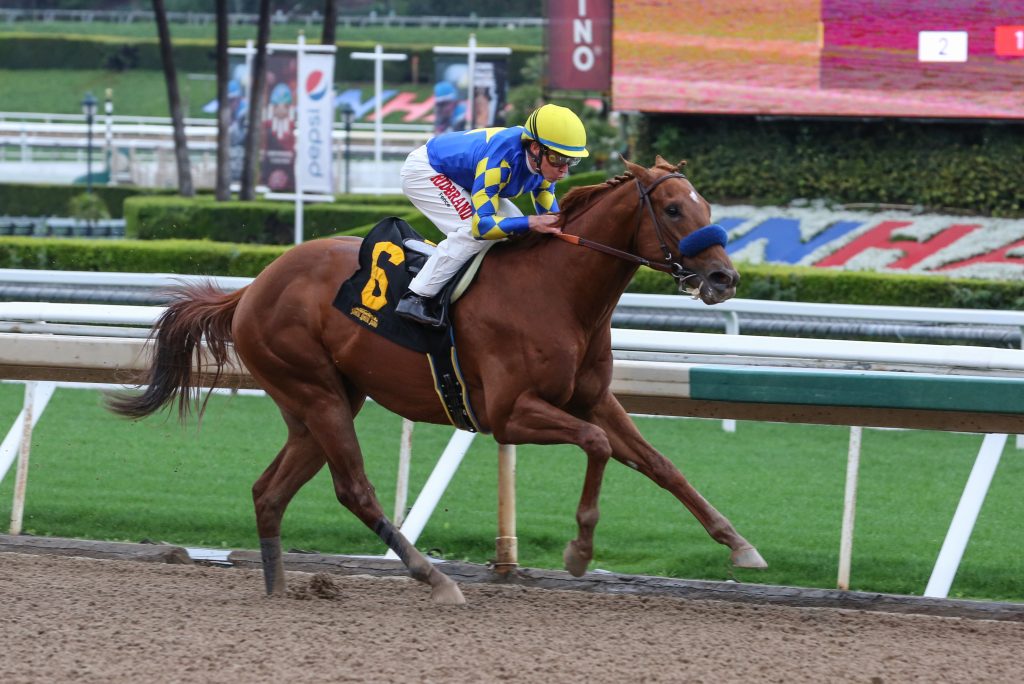
Charlatan Cruises Home To Victory At Santa Anita Park
While Will Rogers Downs and Fonner Park enjoy unimagined handle, most of the rest of the thoroughbred racing world waits in limbo. The Keeneland and Churchill spring meets are canceled. NYRA closed Aqueduct early and has no firm plans for how – or even whether – to go forward with the Belmont and Saratoga meets. The authorities in California have shut down Santa Anita and Golden Gate.
At some point – perhaps June, perhaps September – racing will return to some semblance of normality, with or without on-track spectators. By itself, the absence of big crowds doesn’t make a lot of day-to-day difference in total handle; last year only 8.25% of the money bet on the races was actually bet at the track. Attendance does matter, though, for boutique meets like Keeneland, Del Mar and Saratoga, and for big days like the Triple Crown races and the Breeders’ Cup.
When that new normal returns, will there be any horses to race or any trainers left to condition them? The racing industry has been in decline for some time; it has been harder and harder for anyone to make a living at it. Will the current shutdown push tracks, trainers and owners over the edge? My last column looked at the impossible economics of being a public trainer, at least in New York. Today’s piece looks at what those economics are like from the owner’s side. It’s not an encouraging picture.
Let’s start with the broad outlines. Last year, there were 36,207 thoroughbred races in the US. (All these figures come from the Jockey Club Fact Book.). That’s a decline of 51% from 30 years ago, but the US foal crop has declined by 56% in the same period, from more than 44,000 in 1989 to just over 19,000 last year. Those races last year awarded $1.168 billion in purses – a decline of 22% if measured in inflation-adjusted dollars from 1989 – for an average purse, across the entire US, of $32,256.
Let’s do two more pieces of arithmetic. Average field size in the US last year was 7.5 starters per race, and the average horse that raced at all made only 6.18 starts all year – a marked decline from the field size of 8.91 starters per race and the eight starts per horse per year that were normal 30 years ago. Multiplying the average purse by average starts per horse and dividing by starters per race, we get average earnings per horse (that is, each horse that started at least one race in 2019) of $26,579. Now that’s not a terribly helpful figure; it lumps together horses that raced at Les Bois Park in Idaho or Evangeline Downs in Louisiana with those that raced at the rich Keeneland, Saratoga and Kentucky Downs meets. So, let’s say, for the sake of argument, that a horse racing at the NYRA tracks in New York might have at least twice the average earnings of a horse racing in Idaho or Louisiana. In the absence of publicly available NYRA financial statements – NYRA stopped making them public some years ago – it’s difficult to get much more precise than that. So, our typical New York-based horse would earn about $53,000 for the year. How does that compare to the cost of keeping that horse in training?
Let’s look at the economics from the point of view of an owner who has a few mid-level horses in training at a NYRA track. Let’s assume that each horse spends three months a year on the farm, three months getting ready to race, and six months actually racing, accounting for those 6.18 starts per runner. Meanwhile, our owner is paying training fees of, say, $110 a day for nine months at the race track, and perhaps $50 a day while the horse is getting some R&R, or, more likely, recovering from injury, on the farm. That’s a base annual cost of just under $35,000. Now let’s add in the extras. Moderate vet bills in New York, based on my own experience managing the Castle Village Farm racing partnerships, will run at least $500 a month. And baby needs a new pair of shoes – every month. At $225 a set, that’s another $2,500 or so annually. And you’d better hope baby doesn’t have hoof problems that require the magic touch of Ian MacKinlay or other super farriers, at something closer to $500 a pair. Then there’s the cost of tack and feed supplements that trainers increasingly are forced to pass on to their owners. At least $100 a month. And, if your horse is lucky enough to spend the summer at Saratoga, there’s another $700 for the van ride up and back, and probably an additional $1,000 for the surcharge that most trainers say they’re forced to add on to their Saratoga day rate.
That’s roughly $46,400 a year, before the horse even races. Every time it does go to the starting gate, there are additional charges. Most trainers will charge extra for having to send a groom and hot walker over to the paddock. And NYRA charges for Lasix administration and for thoroughbred retirement. Altogether, each start costs about $300, not counting the trainer’s and jockey’s share of the purse. So, at 6.18 starts per horse per year, that’s another $1,800 or so. Let’s round it off to $48,000 all-in.
Now let’s say your horse turns out to be one of the few that occasionally earns a significant piece of the purse; in New York, the winner gets 55% of the total purse, second place gets 20% and third gets 12%. Out of that purse money the trainer gets at least 10% – some trainers take as much as 13% – and the jockey averages about 8%. And if you win, there’s the cost of the win photo, and at least $100 of your money for the winner’s groom, not to mention drinks for the 20 close friends you’ve invited to the winners’ circle. Let’s call it a minimum of 20% off the top of any purse money the horse wins.
So, if our typical horse earns $53,000 for the year (that is, twice the national average), the owner might net at most 80% of that, or $43,900. That’s less than even the lowest-cost trainer in New York charges to keep your horse fit and ready to race. In other words, even in the richest year-round racing circuit in the country, the average race horse will lose money. And in jurisdictions where purses are much lower than New York – pretty much the rest of the country – the situation is no better. Costs may be lower, but so are earnings; remember, that hypothetical average US horse earned only $26,579 last year.
Things might be different at the top of the thoroughbred class structure – the owners who send their six- and seven-figure auction purchases to Chad Brown, Todd Pletcher or, until lately, Kiaran McLaughlin. Those horses, at least some of them, will earn a lot more money. But they’ll also cost more to train, both in higher day rates for the top trainers and in higher vet bills. With a very few exceptions, those high-priced yearlings and two-year-olds pay their owners back only if they’re good enough to go on to stallion careers or to be sold as broodmare prospects.
Trainers lose money on every stall they fill. Owners lose money on almost every horse they buy or raise. With the pause that the coronavirus is forcing on the industry, more folks in both categories might be reconsidering their business model. That’s not likely to turn out well.


